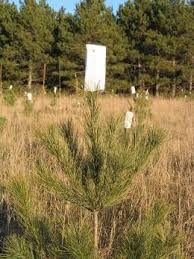We have moved into November and a sacred holiday to Wisconsinites is approaching… deer hunting. For those of us particularly interested in trees, this is one important management tool for protecting young trees. As the snow approaches and food options become more limited, it is a good time to think about further protecting trees from deer, especially conifers. This month we’ll talk about four options particular to limiting deer damage, but we’ll also cover a few other damaging agents.
Fencing an entire planting area is one option but can be expensive. However, your tree planting is an investment, and this is a one option for protecting it. Research shows that fences of 8 feet tall are the most effective, and the material type depends on how long you might need to maintain the fence. Once the main leaders of the trees get above the feeding height of deer, most damage can be avoided, and fences can be removed. (The photo below shows the main leader, or terminal bud, being protected.) Deer exclosures (fenced areas to keep deer out) have been used in forested settings to allow trees to reestablish after a timber sale or storm event.

The other option is to protect individual trees using barriers. Designed tree shelters are one common option, but wire mesh and snow fence can also be used. These are barriers that surround an entire individual tree but allow a tree to still grow. For that reason, they should be 5-6 feet tall or can be raised over time (to again protect the leaders).
Bud caps are another individual tree barrier, but these are specific to the winter. Bud caps are cardstock or other heavy paper material folded to cover the main leader (terminal) buds. Check out this YouTube video for a demonstration. These are only used in the winter since they can limit or prevent growth during the growing season. Bud caps are not the most effective of all the options provided here, but they are the cheapest and easiest option for landowners.
The last option is repellents. This is a liquid that is sprayed on individual trees that deters deer through an unpleasant taste or smell. Unfortunately, research shows the effectiveness of these decreases in the winter since food sources are more limited (meaning deer are more willing to eat, well, pretty much anything) and precipitation can wash it away. Though reapplication is needed after rain, they are proven to be more effective in the growing season.
Various small mammals can also be a nuisance to our planted trees in the winter. This is where I sit back and tell you when the snow was deeper than my tree shelters, and the rabbits girdled (chewed through the bark all the way around the tree) my prime apple trees. Keep an eye on any individual tree barriers as snow depth increases (lesson learned). If your planting is in an open area, you can encourage predators by maintaining raptor perch trees, or building your own perch.
There are additional things you can do to protect your trees during the growing months, like mowing and controlling competing vegetation, but with snow in the air… let’s get those trees through winter first.
